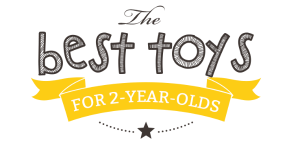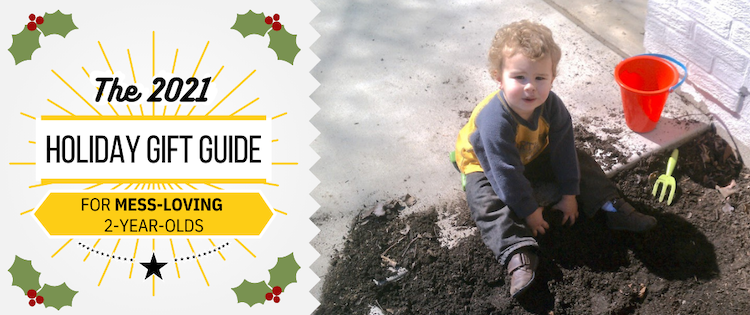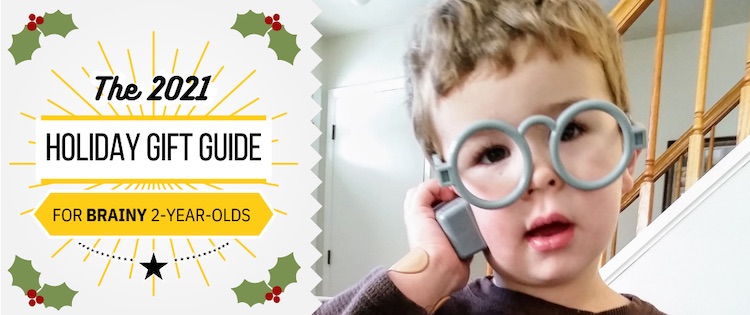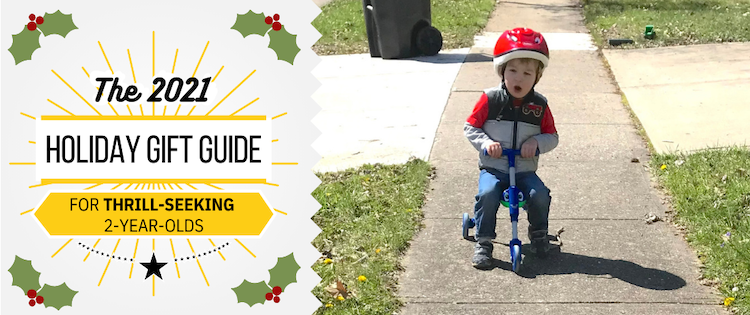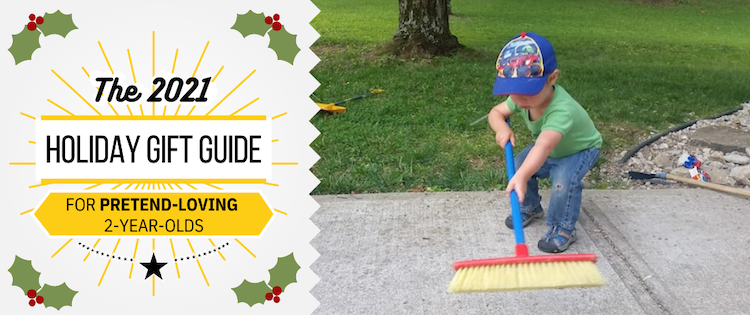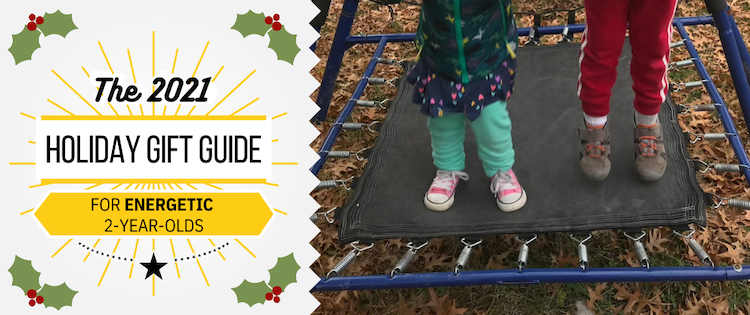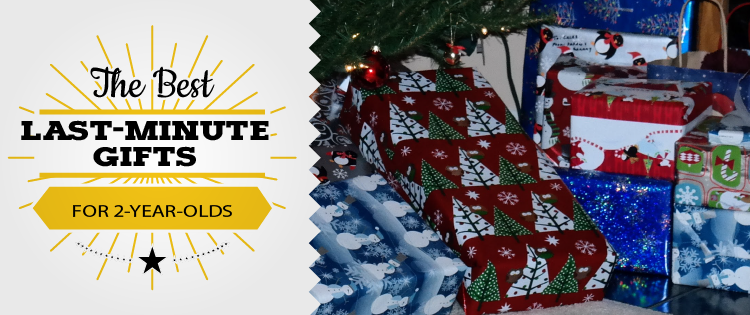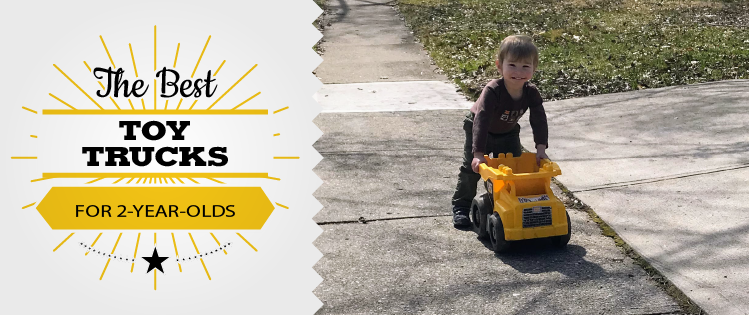Last Updated on June 1, 2022 by admin
Let’s start with the obvious: Letting your toddler enjoy getting messy doesn’t exactly require a purchase on Amazon.
You’ve probably noticed the irony of a toddler preferring to play with a big cardboard box over the toy that came inside it. Similarly, your two-year-old would be just as thrilled to be presented with a large pile of mulch or a stick in the mud as they would some of these toys.
That said, if you’re looking for a toy that celebrates the joy that 2-year-olds feel when squishing mud or splashing water, you’re in the right place.
(As an Amazon Associate, I earn from qualifying purchases.)
A Note on the Term “Sensory”
These gifts for mess-loving 2-year-olds are sometimes called “sensory toys,” because they have to do with the sensations that kids feel when experiencing different textures and sensations.
Technically, though, the term “sensory” can also be used to describe other, whole-body sensations that kids may seek out, such as tight squeezing, spinning or crashing. To clarify, the toys in this article are all geared toward fulfilling the tactile sensory seeking tendencies that toddlers have. (For other, whole-body sensory toys, you may be interested in my post on our basement playroom crash pad, or toys for thrill-seeking toddlers.)
Related post: What Toys Does a 2-Year-Old Actually Need? A Sensory and Developmental Checklist
Article Outline/Shortcuts:
- The Best Big Gifts for Mess-Loving 2-Year-Old ($50 or More)
- Solid Gift Choices From $20-$50 for Mess-Loving 2-Year-Olds
- Smaller Gifts for Mess-Loving 2-Year-Olds ($20 or Less)
The Best Big Gifts for Mess-Loving 2-Year-Olds ($50 or More)
Sensory Tables, Water Tables, and Mud Kitchens

There are lots of “tables” on the market that make it easy for kids to enjoy water and sand at a convenient height for them. Some consist of a plastic or metal bin in a simple frame, while others include bells and whistles like these:
- spouts, tubes, and slides designed to trickle and cascade water
- running water through a faucet via a pump system
- cabinets designed to hold accessories
- dual compartments so kids can keep some sand dry
- tight-fitting covers to keep out bugs, animals, and other elements
- kitchen lookalike features that encourage pretend cooking and baking
- attached umbrellas for shade for outdoor use
- removable sensory bins (this can be convenient for cleaning or replacement)
You can find these products online under terms such as “sand and water table,” “sensory table,” “mud table,” and “mud kitchen.”

Generally, the ones designed for outdoor use will be more expensive, especially if they’re wood instead of plastic. If you’re OK with plastic and with buying secondhand, this is a great opportunity to check out Facebook Marketplace or your local thrift shop. These toys are large and durable and you can generally get them for much less than you’d pay for new.
Keep in mind that you don’t have to pull out all the stops when it comes to a simple sensory table. My father-in-law was kind enough to construct a simple sensory table for my kids out of a $10 storage bin from Lowe’s that works really well for their kinetic sand indoors and their play sand outdoors.
Helper Towers (Kitchen Helpers)
You don’t have to necessarily buy a dedicated table to give your two-year-old access to the joy of running water and soap. A “helper tower” (sometimes called a “kitchen helper”) can give toddlers easy, safer access to an adult-height sink. Or, it can simply give them an easy way to watch and participate in adult’s meal prep.
Many newer models of these helper towers convert to play tables or even to a play tower with a slide, increasing your return on investment and making it more versatile for storage and space use.
Alternatively, although not as exciting as a gift, a small but sturdy step stool can do the trick to help little ones reach some bathroom sinks at a fraction of the cost of a convertible helper tower.
Solid Gift Choices From $20-$50 for Mess-Loving 2-Year-Olds
Play Sinks

The former Waldorf/Montessori preschool mom in me would prefer that kids manipulate actual food and utensils instead of toy replicas. However, I can see how this type of toy could be a hit.
Essentially, you could just put this play sink over a towel on top of a child-sized table instead of bothering with one of the more expensive water tables or kitchen helpers.
Make sure to check the reviews before you buy to make sure you don’t buy one that breaks right away, which seems to be an issue with these. (They’re battery-powered and always getting wet, which seems like a tricky combination.)
Bubble Machines
As I wrote in my full post on bubble machines for 2-year-olds, bubbles are a classic source of entertainment for toddlers.
Bubble machines eliminate messy spills, arguments over who gets to hold the bubble wand, and bubble-blowing-induced headaches for adults. Most importantly, though, bubble machines produce way more bubbles than any adult human could. The effect of all those bubbles is extremely exciting to kids. (Heck, they’re fun for adults, too! There’s a reason there are bubble machines at wedding reception venues and clubs).
Metal Garden Tools
My oldest son got these metal garden tools from a loving aunt for his first birthday. Both of my kids went on to use them extensively for years.
There’s just something especially appealing about toys that actually work and aren’t just for show. (Anyone who has tried to use a plastic toy rake will know what I mean.)
That said, be advised that these tools are technically recommended for age 3 and up. That’s probably either because of small parts that could come loose, or because it’s a little bit of a risk to let a 2-year-old swing a spiky metal rake around. (Related post: Small Parts Warnings: How Scared Should You Be?)
Smaller Gifts for Mess-Loving 2-Year-Olds ($20 or Less)
Indoor Sand Toys (Sculpting Toys)

Toddlers are generally content to squish clay, sand, or mud without tools and accessories.
That said, sprinkling in a few tools here and there can be a great way to keep them coming back to the sensory table.
Outdoor Sand Toys
Any sturdy sand pail and shovel will get tons of use throughout a childhood.
Green Toys is a great brand that produces really durable plastic toys from recycled milk jugs. You can even put these toys in the dishwasher when they need a good wash.
Mixing Cups and Bowls
Sure, these aren’t a kid’s toy, and they arent’ marketed as such. But I’ve often watched my own toddlers play with mixing bowls, measuring cups, and even sauce pans enough to know that they can be just as entertaining.
These have a nesting ability that’s similar to other nesting toys, and they have the bonus of actually being useful in the kitchen, as well.
Play Doh or Kinetic Sand
Water play is probably the safest and easiest form of sensory play for 2-year-olds.
However, if you’re pretty sure your own 2-year-old is past the phase where they eat random stuff, or you’re willing to keep a close eye on them while they play, play dough can be very engaging for toddlers. You can make play dough at home (I used this recipe). However, considering that products like raw flour can actually be unsafe to handle and eat, store-bought Play-Doh might be a safer option.
Play Doh does market itself as being for ages 2 and up, so it probably won’t do much damage if swallowed. The biggest problem with all forms of play dough, including the Play Doh brand, is that it dries out fairly quickly and leaves crumbs everywhere.
I preferred Kinetic Sand to play dough because it doesn’t dry out. It’s mostly made of sand, but includes polymers that make it stick to itself. This makes it interesting to play with, but can also make it extra dangerous if swallowed, so you’ll definitely need to monitor its use with young toddlers.
Scoops, Tweezers, and Sensory Accessories
These scoops and bowls can be used with play sand, but they can also be used with other sensory activities.
A quick internet search for sensory table activities turned up tables filled with sprinkles, corn kernels, and oatmeal, all of which kids would enjoy scooping and spooning into cups.
Of course, you’ll have to do a bit of research to make sure any food product is safe for your toddler to play with after considering choking hazards, potential allergies, and potential contamination hazards (like harmful bacteria growing in it).
For Older 2-Year-Olds: Eyedroppers
These are technically for 3 and up, but some reviews said that 2-year-olds could use them, too — more in an experimental, just-squeeze-the-liquid-in-and-out kind of way. One toddler was shown dotting little cotton pads with colored water. Older toddlers can get into things like mixing different drops of colored water together to see how the colors change.
